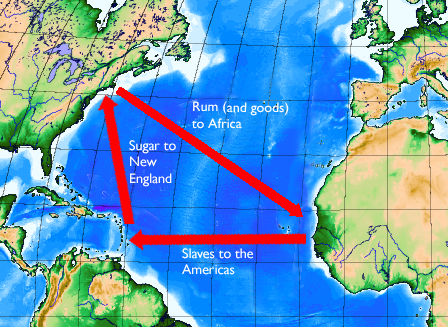History of Agriculture in the U.S.
The agricultural history of the US is long and complex. The United States had vast stretches of farmland, varying in quality from very good to poor, plus even larger amounts of rangelands.
Slavery's role in agriculture 1680 - 1870
Triangle Trade 1680 - 1810
The system involved:
- slaves (brought from Africa to the Caribbean and other points to work on sugar plantations)
- rum, distilled from sugar (shipped to Europe)
- sugar (shipped from the Caribbean and Brazil to Europe)
A nation built on agriculture 1610 - 1770
Frontier expansion: 1770-1850
Railroad Age: 1850-1910
The Homestead Act (1862)
The government encouraged agricultural expansion more directly with the Homestead Act, passed in 1862. The Homestead Act offered 160 acres practically free to any citizen who was voluntarily willing to develop land for use of consumption and farming.
It was hoped that this opportunity would be more attractive to farmers because they wanted to expand the agricultural development in the western states. Practically speaking, this expansion did not successfully occur. There was simply not enough rainfall in the West that would grow healthy crops because the farmers did not have the amount of land that the Homestead Act provided.
Mechanization 1910 - 1930
Great Depression and War: 1930-1945
Postwar Changes
Decline of Cotton and Rural Exodus
Since the 1960s high technology farming, including new hybrids for wheat, rice, and other grains, better methods of soil conservation and irrigation, and the growing use of improved fertilizers has led to the production of more food per capita, not only in the United States, but in much of the rest of the world. See Green Revolution
Bibliography
Surveys
- Willard W. Cochrane. The Development of American Agriculture: A Historical Analysis (1993)
- Fite, Gilbert C. American Farmers: The New Minority (U of Indiana Press, 1981)
- R. Douglas Hurt, American Agriculture: A Brief History (2002)
- Russell, Howard. A Long Deep Furrow: Three Centuries of Farming In New England (1981)
- John T Schlebecker. Whereby we thrive: A history of American farming, 1607-1972 (1972)
Before 1775
- Bidwell, Percy and Falconer, John I. History of Agriculture in the Northern United States 1620-1860 (1941)
- Allan Kulikoff, From British Peasants to Colonial American Farmers (1992)
- Galenson, David. “The Settlement and Growth of the Colonies,” in Stanley L. Engerman and Robert E. Gallman (eds.), The Cambridge Economic History of the United States: Volume I, The Colonial Era (1996).
1775-1860: North
- Bidwell, Percy and Falconer, John I. History of Agriculture in the Northern United States 1620-1860 (1941)
1775-1860: South
- Gray, Lewis Cecil. History of Agriculture in the Southern United States to 1860. 2 vol (1933), classic in-depth history
- Gennovese, Eugene. Roll, Jordan Roll (1967), the history of plantation slavery
1860-1920
- Fite, Gilbert C. The Farmers' Frontier: 1865-1900 (1966)
- Fred Albert Shannon. Farmer's Last Frontier: Agriculture, 1860-1897 (1945) [http://www.questia.com/PM.qst?a=o&d=59123553 comprehensive coverage
Since 1920
- Dean, Virgil W. An Opportunity Lost: The Truman Administration and the Farm Policy Debate. U. of Missouri Press, 2006. 275 pp.
Historiography
- Bogue, Allan G. "Tilling Agricultural History with Paul Wallace Gates and James C. Malin." Agricultural History 2006 80(4): 436-460. Issn: 0002-1482 Fulltext: in Ebsco
Primary sources
- Phillips, Ulrich B.
